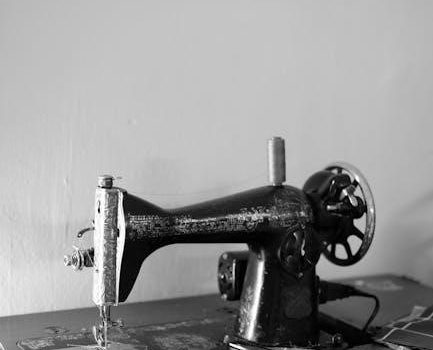kenmore sewing machine model 385 manual
Category : Manuals
The Kenmore Sewing Machine Model 385 is a versatile and essential tool for various sewing tasks․ Its user-friendly design and comprehensive manual make it ideal for both beginners and experienced sewists, ensuring optimal performance and ease of use․
1․1 Overview of the Kenmore Sewing Machine Model 385
The Kenmore Sewing Machine Model 385 is a versatile and reliable appliance designed for a wide range of sewing tasks․ Known for its sturdy build and durable materials, this machine is ideal for both beginners and experienced sewists․ It offers a variety of features, including multiple stitch options and a user-friendly interface, making it suitable for sewing, repairing, and crafting projects․ The machine’s manual provides detailed guidance on setup, operation, and maintenance, ensuring optimal performance․ With its comprehensive design, the Kenmore 385 is a practical choice for anyone looking to create professional-quality results at home․ Its durability and ease of use make it a favorite among sewing enthusiasts․
1․2 Importance of the Manual for Optimal Usage
The manual for the Kenmore Sewing Machine Model 385 is essential for ensuring optimal performance and longevity of the machine․ It provides detailed instructions on threading, bobbin winding, tension adjustment, and troubleshooting common issues․ By following the manual, users can avoid errors, maintain proper machine function, and achieve professional-quality results․ The guide also includes safety precautions and maintenance tips, such as cleaning and oiling, to keep the machine in excellent condition․ Additionally, the manual covers advanced features like stitch selection and presser foot usage, helping users unlock the machine’s full potential․ Referencing the manual regularly ensures that users maximize their sewing experience and extend the life of their Kenmore 385․
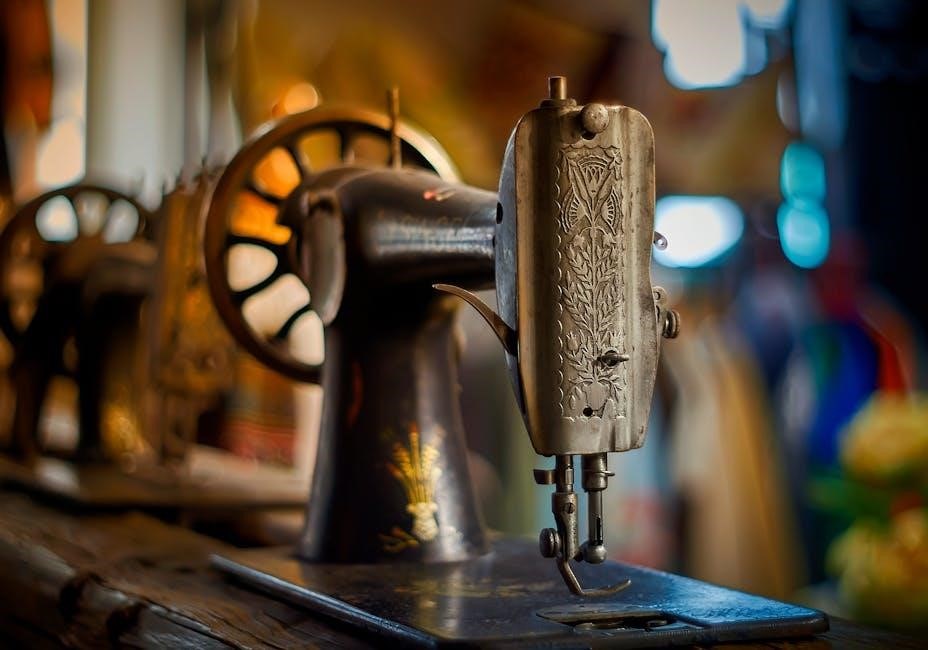
Setting Up the Sewing Machine
Setting up the Kenmore Sewing Machine Model 385 involves unpacking, inspecting, and assembling if required․ Locate the model and serial numbers for future reference, ensuring everything is in working order before use․
2․1 Unpacking and Initial Inspection
Begin by carefully unpacking the Kenmore Sewing Machine Model 385 from its box․ Inspect the machine for any visible damage or scratches․ Check all components, including the power cord, presser feet, and accessories, to ensure nothing is missing or damaged․ Verify that the machine is complete and in good condition before proceeding․ Locate the model number and serial number on the nomenclature plate, usually found on the back or bottom of the machine, and record them for future reference․ Refer to the manual for guidance on proper setup and assembly if required․ Ensure all parts are accounted for and in working order before initial use․
2;2 Locating the Model Number and Serial Number
The model number and serial number of your Kenmore Sewing Machine Model 385 are crucial for warranty claims, service requests, and ordering parts․ These numbers are typically found on a nomenclature plate located on the back or bottom of the machine․ The model number starts with “385” and is followed by additional digits, while the serial number is a unique sequence that identifies your specific unit․ Carefully record both numbers in the space provided in your manual or in a secure location for easy access․ This information is essential for contacting Sears Service Centers or verifying warranty coverage․ Always have these details handy for any future maintenance or repair needs․
2․3 Assembling the Machine (if required)
Some Kenmore Sewing Machine Model 385 units may require minor assembly upon unpacking․ Begin by carefully removing all components from the packaging and inspecting for any damage․ If your machine comes partially disassembled, refer to the manual for specific instructions on attaching parts like the sewing table, presser foot, or additional accessories․ Ensure all screws and bolts are securely tightened, but avoid over-tightening to prevent damage․ Place the machine on a stable, flat surface before plugging it in․ If unsure about any step, consult the manual or contact Sears customer support for assistance․ Proper assembly is key to ensuring smooth operation and longevity of your sewing machine․
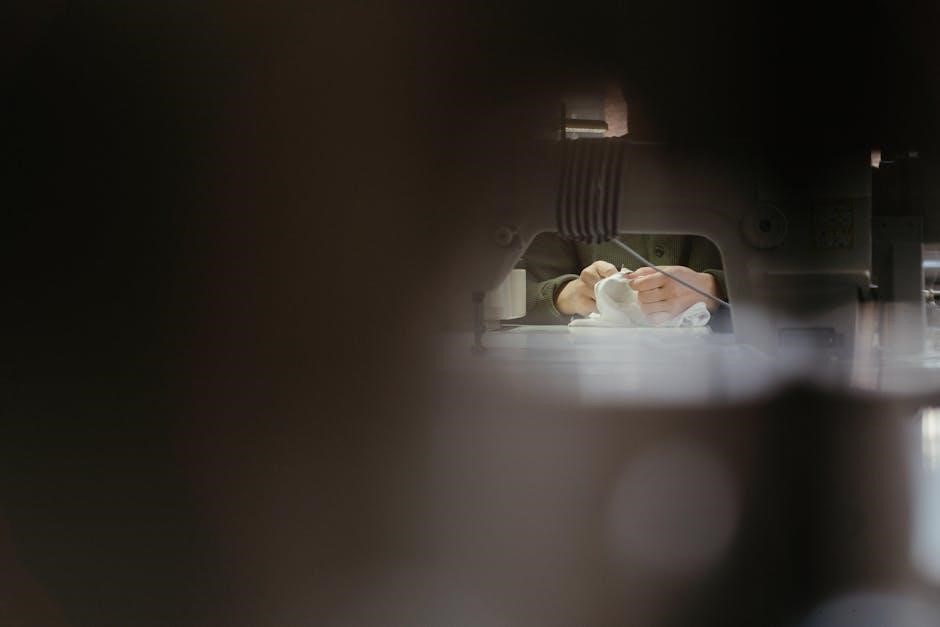
Threading the Sewing Machine
Threading the Kenmore Sewing Machine Model 385 is straightforward when following the manual’s guidance․ Proper thread alignment and tension ensure smooth stitching and optimal performance․
3․1 Step-by-Step Guide to Threading the Machine
Threading the Kenmore Sewing Machine Model 385 requires careful attention to detail to ensure proper function․ Start by placing the spool of thread on the spool pin․ Take the end of the thread and insert it into the machine’s tension discs, located at the top of the machine․ Follow the path outlined in the manual, guiding the thread through the take-up lever and down toward the needle․ Insert the thread through the needle’s eye from front to back․ Pull gently to remove any slack and ensure the thread is seated correctly․ Refer to the manual’s diagrams for visual guidance if needed․
3․2 Understanding Thread Tension Adjustment
Proper thread tension is crucial for consistent stitching on the Kenmore Sewing Machine Model 385․ The upper thread tension can be adjusted using the small dial located above the needle․ Turning the dial clockwise increases tension, while counterclockwise decreases it․ The bobbin tension, located on the bobbin case, is usually preset but may require adjustment if stitches are uneven․ Always test the tension by gently pulling the thread to ensure it’s not too tight or loose․ Improper tension can lead to issues like loose stitches or fabric puckering․ Refer to the manual for specific guidance on balancing tension for optimal sewing performance․

Bobbin Winding and Installation
Wind the bobbin evenly using the spindle, ensuring the thread is taut․ Install the bobbin into the machine’s bobbin case, aligning it properly․ Hold the thread firmly to prevent tangles․ Correct installation ensures smooth stitching and prevents operational issues․
4․1 How to Wind the Bobbin Correctly
To wind the bobbin correctly, start by placing an empty bobbin on the spindle․ Thread the machine and pull the thread through the bobbin winding guide․ Hold the thread gently but firmly to avoid tangling․ Begin winding slowly, ensuring the thread wraps evenly around the bobbin․ Avoid overfilling, as this can cause stitching issues․ Once the bobbin is full, cut the excess thread and remove it from the spindle․ Properly wound bobbins are essential for smooth stitching and consistent tension, preventing common sewing problems․
4;2 Installing the Bobbin in the Machine
Insert the wound bobbin into the bobbin case, ensuring it sits correctly in the designated area․ Gently pull the thread to guide it through the tension spring․ Snap the bobbin case into place in the machine’s bobbin compartment․ Close the compartment cover securely․ Pull the thread gently to ensure proper tension is set․ This step ensures the bobbin thread feeds smoothly during sewing․ Proper installation prevents issues like uneven stitches or thread breakage․ Always refer to the manual for specific guidance on your Kenmore 385 model to ensure accurate placement and tension setup․

Stitch Selection and Operation
The Kenmore 385 offers a variety of stitches, including straight, zigzag, and decorative options․ Easily select stitches using the dial or buttons for precise control, enhancing your sewing projects with versatility and creativity․
5․1 Types of Stitches Available on the Model 385
The Kenmore Sewing Machine Model 385 features an extensive range of stitches, including straight, zigzag, and various decorative patterns․ These stitches are ideal for different fabrics and sewing projects, from delicate materials to heavy-duty tasks․ The machine also includes stretch stitches for knits and specialized stitches for home decor․ This versatility allows users to tackle a wide array of sewing needs with precision and creativity․ The stitch selection dial makes it easy to choose the perfect stitch for any project, ensuring professional-quality results․ Whether you’re making clothes, quilts, or home decor items, the Model 385 has the right stitch for the job․ Its comprehensive stitch library ensures that sewists of all skill levels can achieve stunning outcomes․
5․2 Adjusting Stitch Length and Width
Adjusting the stitch length and width on the Kenmore Sewing Machine Model 385 is essential for achieving the desired results․ The machine features a stitch length dial and a stitch width dial, allowing precise control․ For straight stitches, set the width to a minimum, and adjust the length based on fabric type․ For zigzag stitches, both length and width can be customized․ The manual provides guidelines for common fabrics, helping users choose appropriate settings․ Proper tension maintenance is crucial to prevent fabric bunching or thread breakage․ Testing on scrap fabric before sewing ensures accurate settings․ This feature-rich machine offers flexibility, enabling users to adapt stitches to various projects with ease and precision, ensuring professional-quality outcomes for all sewing tasks․
Maintenance and Care
Regular cleaning, oiling, and proper storage are essential for maintaining the Kenmore Sewing Machine Model 385․ This ensures smooth operation and prolongs its lifespan effectively․
6․1 Cleaning the Sewing Machine
Regular cleaning is crucial for maintaining the Kenmore Sewing Machine Model 385․ Turn off and unplug the machine before starting․ Use a soft brush or lint remover to gently sweep away dust, thread scraps, and debris from the bobbin area, needle plate, and tension discs․ Avoid using liquids or harsh chemicals, as they may damage the machine’s finish or internal components․ For stubborn lint, a small, dry cotton swab can be used to clean tight spaces․ After cleaning, ensure all parts are dry and free of residue․ Proper cleaning prevents dust buildup, reduces friction, and ensures smooth operation․ Regular maintenance helps extend the machine’s lifespan and performance․
Tips: Clean after every project to prevent lint accumulation and keep the machine running efficiently․
6․2 Oiling the Machine for Smooth Operation
Regular oiling is essential to maintain the smooth operation of the Kenmore Sewing Machine Model 385․ Locate the oiling points, typically found near the bobbin area and handwheel, as indicated in the manual․ Use high-quality sewing machine oil to ensure optimal performance․ Apply a few drops to the specified areas, then gently turn the handwheel to distribute the oil evenly․ Avoid over-oiling, as excess oil can attract dust and cause maintenance issues․ After oiling, run the machine without fabric for a few minutes to allow the oil to circulate․ Proper lubrication reduces friction, prevents wear, and ensures quiet, efficient stitching․ Regular oiling is crucial for extending the machine’s lifespan and maintaining its reliability․
Tips: Always use the oil recommended in the manual to avoid damaging your machine․
6․3 Storing the Machine Properly
Proper storage is crucial to maintain the Kenmore Sewing Machine Model 385’s performance and longevity․ After cleaning and oiling, cover the machine with a dust cover or plastic bag to protect it from dust and debris․ Store it in a dry, cool place away from direct sunlight and moisture․ Avoid extreme temperatures, as they may damage the machine’s components․ Keep the machine upright to prevent oil from leaking into unwanted areas․ Store accessories like bobbins, needles, and presser feet in a separate, labeled container․ Regularly inspect stored items for signs of wear or damage․ Proper storage ensures the machine remains in excellent condition for future use․
Remember to store the machine in a secure location to prevent accidental damage or tampering․
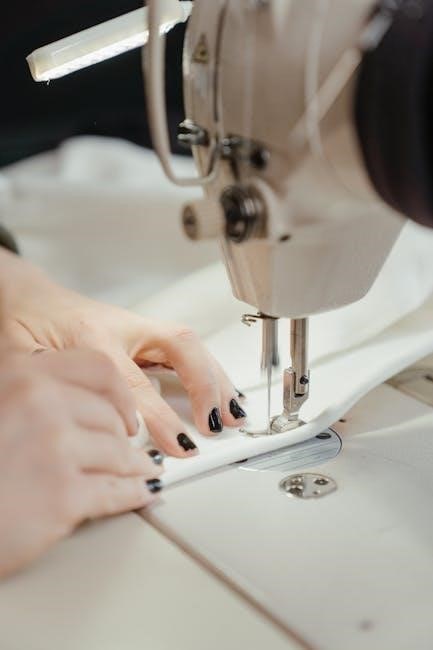
Troubleshooting Common Issues
The Kenmore 385 manual helps users troubleshoot common issues like thread breakage, tension problems, and bobbin-related concerns, ensuring smooth sewing operations․
7․1 Diagnosing Thread Breakage Problems
Thread breakage on the Kenmore 385 sewing machine can often be traced to improper threading, incorrect tension settings, or using the wrong needle type․ To diagnose, first, check if the thread is correctly threaded through the machine, ensuring it follows the designated path without twists․ Next, inspect the tension dials to confirm they are set appropriately for the fabric type․ If issues persist, examine the bobbin area for proper winding and installation; Additionally, ensure the needle is compatible with the thread and fabric being used․ If the problem continues, consult the manual for detailed troubleshooting steps or consider professional servicing to resolve the issue effectively․
7․2 Fixing Tension Imbalances
Tension imbalances on the Kenmore 385 sewing machine can lead to uneven stitching or thread breakage․ To address this, start by ensuring the thread is correctly threaded through the machine, following the designated path without twists․ Next, check the top thread and bobbin tension dials, adjusting them slightly to achieve balanced stitches․ Using the appropriate needle type for your fabric is crucial to maintaining proper tension․ Regularly cleaning the machine to remove dust and lint can also prevent tension issues․ If problems persist, consult the manual for specific adjustment techniques or consider professional servicing to restore optimal performance and ensure smooth operation․
7․3 Solving Bobbin-Related Issues
Bobbin-related issues on the Kenmore 385 sewing machine can disrupt your sewing projects․ To resolve these, ensure the bobbin is wound correctly and evenly, avoiding over-or under-filling․ Properly install the bobbin in the case, making sure it’s seated securely and aligned with the machine’s mechanisms․ Check for lint or debris in the bobbin area, as this can cause improper threading or tension․ If the bobbin thread isn’t catching, inspect the needle for damage or incorrect installation․ Using the correct bobbin type for your machine is essential․ If issues persist, refer to the manual for troubleshooting steps or contact a Sears service center for professional assistance to ensure smooth operation and prevent further complications․

Advanced Features of the Kenmore 385
The Kenmore 385 features advanced functions like the zigzag stitch for decorative sewing and specialized presser feet for handling various fabrics and tasks efficiently․
8․1 Using the Zigzag Stitch Function
To use the zigzag stitch on the Kenmore 385, start by selecting the correct stitch option using the stitch selector dial․ Ensure the machine is properly threaded and the correct presser foot is attached for smooth fabric movement․ Adjust the stitch length and width as needed for your project․ Practice on scrap fabric to achieve the desired effect before sewing on your final material․ This feature is ideal for decorative sewing and adding unique textures to your creations․
8․2 Working with Specialized Presser Feet
Specialized presser feet are essential for optimizing the performance of your Kenmore 385 sewing machine․ The zigzag foot is ideal for general sewing, while the blind hem foot is perfect for invisible hems․ The zipper foot allows for precise stitching near zippers or thick seams․ To attach a presser foot, lift the foot holder, align the foot with the shank, and snap it into place securely․ Always unplug the machine before changing feet for safety․ Using the right presser foot ensures better fabric control, reduces bunching, and achieves professional-looking results․ Consult the manual for specific instructions on using each foot effectively for various projects․
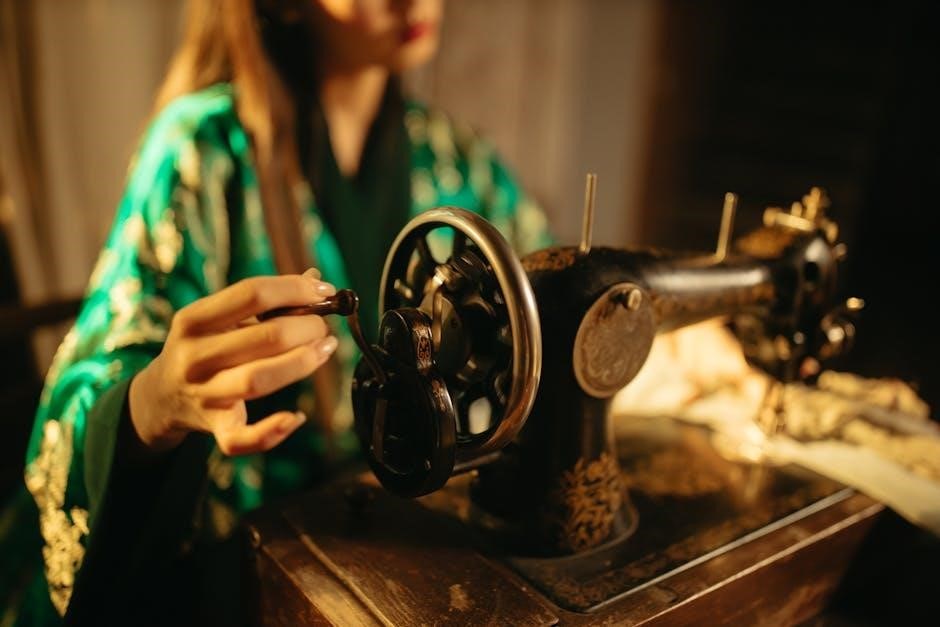
Safety Instructions
Always handle sharp objects like needles and scissors with care․ Avoid wearing loose clothing near moving parts․ Keep children away while operating the machine․ Follow all safety guidelines to prevent accidents and ensure safe sewing experiences․
9․1 General Safety Precautions
Always prioritize your safety while operating the Kenmore Sewing Machine Model 385․ Handle sharp objects like needles and scissors with care to avoid injuries․ Keep loose clothing or long hair tied back to prevent entanglement with moving parts․ Ensure the machine is placed on a stable, flat surface to avoid accidental tipping․ Never leave the machine unattended while it is in operation, especially if children are nearby․ Avoid operating the machine when fatigued or distracted․ Regularly inspect the machine for damage or wear and tear․ Follow all electrical safety guidelines to prevent shocks or malfunctions․ By adhering to these precautions, you can ensure a safe and enjoyable sewing experience․
9․2 Electrical Safety Guidelines
To ensure safe operation of the Kenmore Sewing Machine Model 385, follow these electrical safety guidelines․ Always unplug the machine when not in use or during maintenance to prevent accidental start-ups․ Avoid using damaged power cords or plugs, as they can cause electrical shocks․ Keep the machine away from water and moisture to prevent short circuits․ Use only the power source specified in the manual to avoid overloading the motor․ Never touch electrical components with wet hands or while standing on a wet surface․ Store the machine in a dry, cool place to protect its electrical systems․ If you suspect a malfunction, disconnect the power immediately and contact a qualified technician․ Prioritizing electrical safety helps protect both you and your machine from potential hazards․

Compatible Accessories
The Kenmore Sewing Machine Model 385 supports various accessories, including specialized presser feet, additional bobbins, and extension tables․ These enhance functionality and versatility for different sewing projects․
10․1 List of Recommended Presser Feet
The Kenmore Sewing Machine Model 385 is compatible with a variety of presser feet to enhance sewing capabilities․ Recommended options include the zigzag foot for decorative stitching, the zipper foot for precise zipper installation, and the buttonhole foot for creating professional buttonholes․ Additionally, the blind hem foot is ideal for sewing invisible hems, while the walking foot helps manage thick fabrics like denim․ These accessories are designed to optimize performance and expand the machine’s versatility for diverse sewing projects․ They can be purchased from Sears or authorized Kenmore dealers, ensuring compatibility and quality․
10․2 Additional Accessories for Enhanced Sewing
Enhance your sewing experience with additional accessories designed for the Kenmore Sewing Machine Model 385․ These include extra bobbin cases for quick thread changes, replacement needles in various sizes, and quilting bars for managing larger projects․ The embroidery hoop allows for intricate designs, while specialized presser feet like the edge joining foot and overlock foot expand stitching options․ Maintenance tools, such as brushes and screwdrivers, are also available to keep the machine in top condition․ These accessories can be purchased from Sears or authorized Kenmore dealers, ensuring compatibility and quality․ They help users achieve professional results and maintain the machine’s performance for years to come․
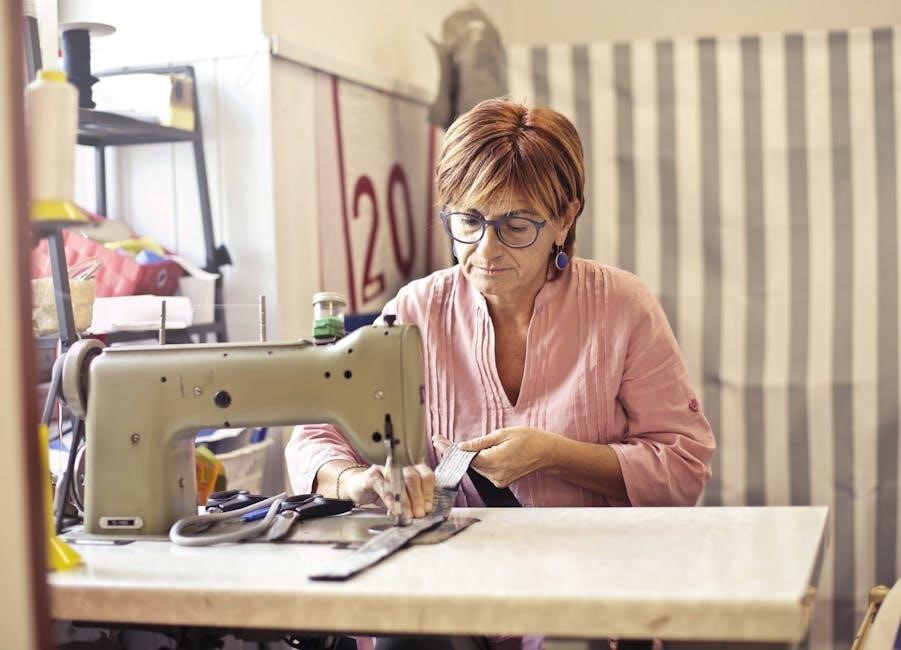
Warranty and Service Information
The Kenmore Sewing Machine Model 385 is backed by a comprehensive warranty․ Contact Sears Service Centers for repairs or inquiries, ensuring to provide the machine’s model and serial number for efficient assistance․
11․1 Understanding the Warranty Coverage
The Kenmore Sewing Machine Model 385 is covered by a limited warranty that protects against defects in materials and workmanship․ The warranty period varies depending on the specific model and components, ensuring coverage for parts and labor under normal use․ To maintain warranty validity, users must register their machine and retain the purchase receipt․ The warranty does not cover damages resulting from misuse, improper maintenance, or unauthorized repairs․ For detailed terms and conditions, refer to the warranty section in the manual․ Always record the model number and serial number for warranty service requests․ Contact Sears Service Centers for any warranty-related inquiries or claims․
11․2 Contacting Sears Service Centers
To contact Sears Service Centers for assistance with your Kenmore Sewing Machine Model 385, visit their official website or call their customer service hotline․ Enter your machine’s model number, which can be found on the nomenclature plate, to locate the nearest service center․ Have your model number and serial number ready, as well as a detailed description of the issue, to expedite the process․ Sears Service Centers provide authorized repairs, maintenance, and genuine parts, ensuring your machine remains in optimal condition․ For warranty-related services, ensure your machine is registered and all required documentation is available․ Always use Sears-authorized service centers to maintain warranty validity and ensure reliable support․
Mastering the Kenmore Sewing Machine Model 385 is achievable with this manual․ Follow the guide for efficient operation, proper care, and troubleshooting to ensure longevity and performance․
12․1 Summary of Key Points
This manual provides a comprehensive guide for the Kenmore Sewing Machine Model 385, covering setup, operation, and maintenance․ It includes detailed instructions for threading, bobbin winding, and stitch selection, ensuring optimal performance․ Troubleshooting tips and safety guidelines are emphasized to enhance user experience․ The manual also highlights the importance of proper cleaning, oiling, and storage to extend the machine’s lifespan․ Accessories and warranty information are included for convenience․ By following this guide, users can maximize their sewing efficiency and enjoy a seamless creative process․ Regular maintenance and adherence to safety precautions are key to preserving the machine’s functionality and ensuring years of reliable service․
12․2 Final Tips for Maximizing Machine Performance
To ensure the Kenmore Sewing Machine Model 385 operates at its best, regular maintenance is crucial․ Always thread the machine correctly and adjust tension as needed to prevent thread breakage․ Select the appropriate stitch type for your fabric to achieve professional results․ Keep the machine clean and well-oiled to maintain smooth operation․ Use compatible accessories and presser feet for specific tasks․ Avoid overloading the machine and ensure a stable power supply․ Store the machine properly when not in use to protect it from dust and damage․ By following these tips, you can extend the machine’s lifespan and enjoy consistent, high-quality sewing performance․
